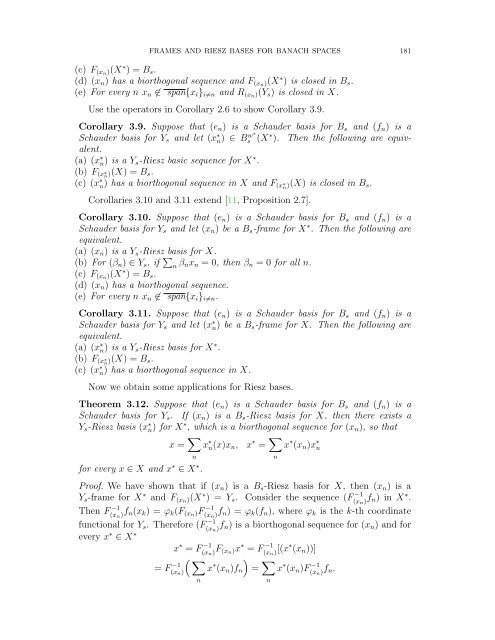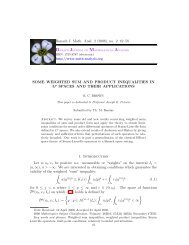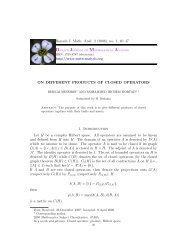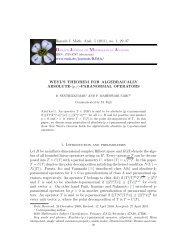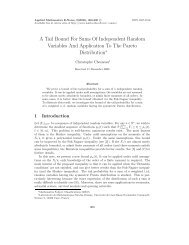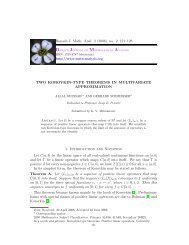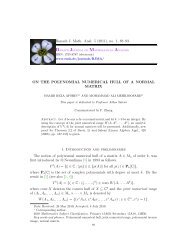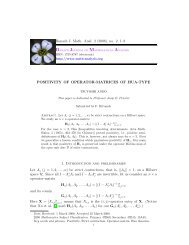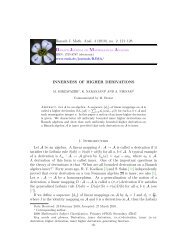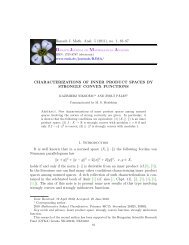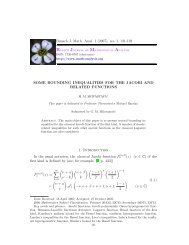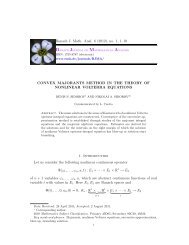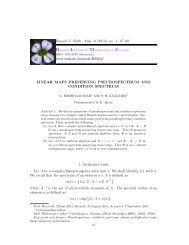FRAMES AND RIESZ BASES FOR BANACH SPACES 181(c) F (xn)(X ∗ ) = B s .(d) (x n ) has a biorthogonal sequence <strong>and</strong> F (xn)(X ∗ ) is closed in B s .(e) For every n x n ∉ span{x i } i≠n <strong>and</strong> R (xn)(Y s ) is closed in X.Use the operators in Corollary 2.6 to show Corollary 3.9.Corollary 3.9. Suppose that (e n ) is a Schauder basis <strong>for</strong> B s <strong>and</strong> (f n ) is aSchauder basis <strong>for</strong> Y s <strong>and</strong> let (x ∗ n) ∈ Bs w∗ (X ∗ ). Then the following are equivalent.(a) (x ∗ n) is a Y s -<strong>Riesz</strong> basic sequence <strong>for</strong> X ∗ .(b) F (x ∗ n )(X) = B s .(c) (x ∗ n) has a biorthogonal sequence in X <strong>and</strong> F (x ∗ n )(X) is closed in B s .Corollaries 3.10 <strong>and</strong> 3.11 extend [11, Proposition 2.7].Corollary 3.10. Suppose that (e n ) is a Schauder basis <strong>for</strong> B s <strong>and</strong> (f n ) is aSchauder basis <strong>for</strong> Y s <strong>and</strong> let (x n ) be a B s -frame <strong>for</strong> X ∗ . Then the following areequivalent.(a) (x n ) is a Y s -<strong>Riesz</strong> basis <strong>for</strong> X.(b) For (β n ) ∈ Y s , if ∑ n β nx n = 0, then β n = 0 <strong>for</strong> all n.(c) F (xn)(X ∗ ) = B s .(d) (x n ) has a biorthogonal sequence.(e) For every n x n ∉ span{x i } i≠n .Corollary 3.11. Suppose that (e n ) is a Schauder basis <strong>for</strong> B s <strong>and</strong> (f n ) is aSchauder basis <strong>for</strong> Y s <strong>and</strong> let (x ∗ n) be a B s -frame <strong>for</strong> X. Then the following areequivalent.(a) (x ∗ n) is a Y s -<strong>Riesz</strong> basis <strong>for</strong> X ∗ .(b) F (x ∗ n )(X) = B s .(c) (x ∗ n) has a biorthogonal sequence in X.Now we obtain some applications <strong>for</strong> <strong>Riesz</strong> <strong>bases</strong>.Theorem 3.12. Suppose that (e n ) is a Schauder basis <strong>for</strong> B s <strong>and</strong> (f n ) is aSchauder basis <strong>for</strong> Y s . If (x n ) is a B s -<strong>Riesz</strong> basis <strong>for</strong> X, then there exists aY s -<strong>Riesz</strong> basis (x ∗ n) <strong>for</strong> X ∗ , which is a biorthogonal sequence <strong>for</strong> (x n ), so thatx = ∑ n<strong>for</strong> every x ∈ X <strong>and</strong> x ∗ ∈ X ∗ .x ∗ n(x)x n ,x ∗ = ∑ nx ∗ (x n )x ∗ nPro<strong>of</strong>. We have shown that if (x n ) is a B s -<strong>Riesz</strong> basis <strong>for</strong> X, then (x n ) is aY s -frame <strong>for</strong> X ∗ <strong>and</strong> F (xn)(X ∗ ) = Y s . Consider the sequence (F −1(x f n) n) in X ∗ .Then F −1(x f n) n(x k ) = ϕ k (F (xn)F −1(x f n) n) = ϕ k (f n ), where ϕ k is the k-th coordinatefunctional <strong>for</strong> Y s . There<strong>for</strong>e (F −1(x f n) n) is a biorthogonal sequence <strong>for</strong> (x n ) <strong>and</strong> <strong>for</strong>every x ∗ ∈ X ∗x ∗ = F −1(x F n) (x n)x ∗ = F −1(x n) [(x∗ (x n ))]= F −1(x n)( ∑ )x ∗ (x n )f n = ∑nnx ∗ (x n )F −1(x n) f n.
182 K. CHO, J.M. KIM, H.J. LEELet x ∈ X. Then x = ∑ n β nx n <strong>for</strong> some sequence (β n ) <strong>of</strong> scalars <strong>and</strong> <strong>for</strong> everyk F −1(x f n) k(x) = ∑ n β nF −1(x f n) k(x n ) = β k . Hence x = ∑ n F −1(x f n) n(x)x n . It isimmediate that (F −1(x f n) n) is equivalent to (f n ). □If B s is reflexive <strong>and</strong> (x n ) is a Y s -<strong>Riesz</strong> basis <strong>for</strong> X, then X is reflexive <strong>and</strong>so (x n ) is a B s -frame <strong>for</strong> X ∗ <strong>and</strong> F (xn)(X ∗ ) = B s by Theorem 3.2 <strong>and</strong> Corollary3.10. Then by the pro<strong>of</strong> <strong>of</strong> Theorem 3.12 we haveTheorem 3.13. Suppose that (e n ) is a Schauder basis <strong>for</strong> B s <strong>and</strong> (f n ) is aSchauder basis <strong>for</strong> Y s . Let B s be reflexive. If (x n ) is a Y s -<strong>Riesz</strong> basis <strong>for</strong> X,then there exists a B s -<strong>Riesz</strong> basis (x ∗ n) <strong>for</strong> X ∗ , which is a biorthogonal sequence<strong>for</strong> (x n ), so thatx = ∑ x ∗ n(x)x n , x ∗ = ∑ x ∗ (x n )x ∗ nnn<strong>for</strong> every x ∈ X <strong>and</strong> x ∗ ∈ X ∗ .If (x ∗ n) ∈ Bsw∗ (X ∗ ) (or B s is reflexive) <strong>and</strong> (x ∗ n) is a Y s -<strong>Riesz</strong> basis <strong>for</strong> X ∗ , then(x ∗ n) is a B s -frame <strong>for</strong> X <strong>and</strong> F (x ∗ n )(X) = B s by Theorem 3.4 <strong>and</strong> Corollary 3.11.Then by the pro<strong>of</strong> <strong>of</strong> Theorem 3.12 we have the following which extends [11,Theorem 2.8].Theorem 3.14. Suppose that (e n ) is a Schauder basis <strong>for</strong> B s <strong>and</strong> (f n ) is aSchauder basis <strong>for</strong> Y s . Let (x ∗ n) ∈ Bsw∗ (X ∗ ) (or B s be reflexive). If (x ∗ n) is aY s -<strong>Riesz</strong> basis <strong>for</strong> X ∗ , then there exists a B s -<strong>Riesz</strong> basis (x n ) <strong>for</strong> X, which is abiorthogonal sequence <strong>for</strong> (x ∗ n), so thatx = ∑ n<strong>for</strong> every x ∈ X <strong>and</strong> x ∗ ∈ X ∗ .x ∗ n(x)x n ,x ∗ = ∑ nx ∗ (x n )x ∗ n4. <strong>Banach</strong> frames <strong>and</strong> atomic decompositionsFor an operator S : B s → X, a sequence (x n ) in X <strong>and</strong> a B s -frame (x ∗ n) in X ∗<strong>for</strong> X, we say that ((x ∗ n), S) (resp. ((x ∗ n), (x n ))) is a <strong>Banach</strong> frame (BF) (resp.an atomic decomposition (AD)) <strong>for</strong> X with respect to B s if(S[(x ∗ n(x))] = x resp. ∑ )x ∗ n(x)x n = xn<strong>for</strong> every x ∈ X. The BF <strong>and</strong> AD <strong>for</strong> <strong>Banach</strong> <strong>spaces</strong> were introduced <strong>and</strong>studied by Gröchenig [15], <strong>and</strong> Casazza, Han, Larson, Christensen <strong>and</strong> Heil [8, 10],respectively. Recently, some abstract theories <strong>for</strong> them were studied by Car<strong>and</strong>o,Lassalle <strong>and</strong> Schmidberg [3, 4], <strong>and</strong> Casazza, Christensen, Stoeva [7]. The purpose<strong>of</strong> this section is to sharpen some recent results [3, 4, 7] <strong>for</strong> the BF <strong>and</strong> AD.First we consider the existence problem <strong>of</strong> the BF <strong>and</strong> AD <strong>for</strong> <strong>Banach</strong> <strong>spaces</strong>.In [8, Theorem 2.10], it was shown that there exists an AD <strong>for</strong> a <strong>Banach</strong> space Xif <strong>and</strong> only if X is separable <strong>and</strong> has the bounded approximation property (BAP).Thus there exist a separable reflexive <strong>Banach</strong> space Z, which does not have theBAP (see [12]), such that there is no AD <strong>for</strong> Z. Also we will see that there is noBF <strong>for</strong> every nonseparable reflexive <strong>Banach</strong> space from the following proposition.
- Page 1 and 2: Banach J. Math. Anal. 7 (2013), no.
- Page 3 and 4: 174 K. CHO, J.M. KIM, H.J. LEENote
- Page 5 and 6: 176 K. CHO, J.M. KIM, H.J. LEE(a)=
- Page 7 and 8: 178 K. CHO, J.M. KIM, H.J. LEE(a) T
- Page 9: 180 K. CHO, J.M. KIM, H.J. LEE(d) (
- Page 13 and 14: 184 K. CHO, J.M. KIM, H.J. LEE(e) T
- Page 15 and 16: 186 K. CHO, J.M. KIM, H.J. LEE(a) T
- Page 17 and 18: 188 K. CHO, J.M. KIM, H.J. LEEsame,
- Page 19 and 20: 190 K. CHO, J.M. KIM, H.J. LEE(c) B
- Page 21 and 22: 192 K. CHO, J.M. KIM, H.J. LEECorol


